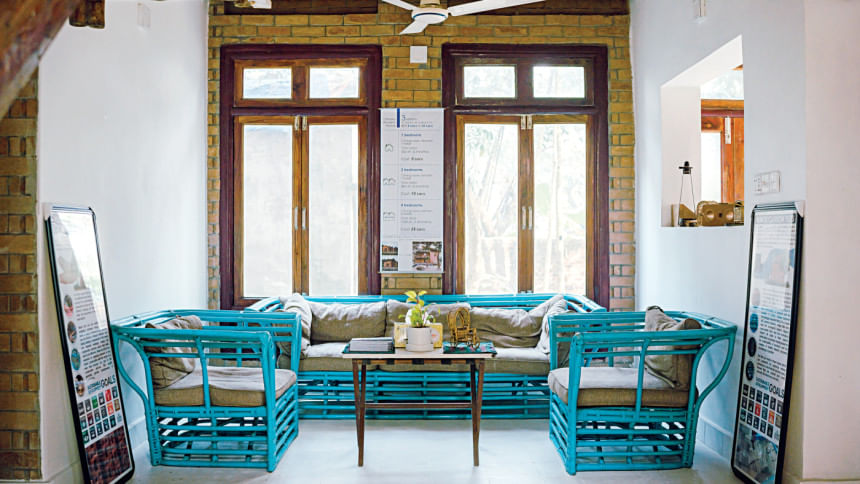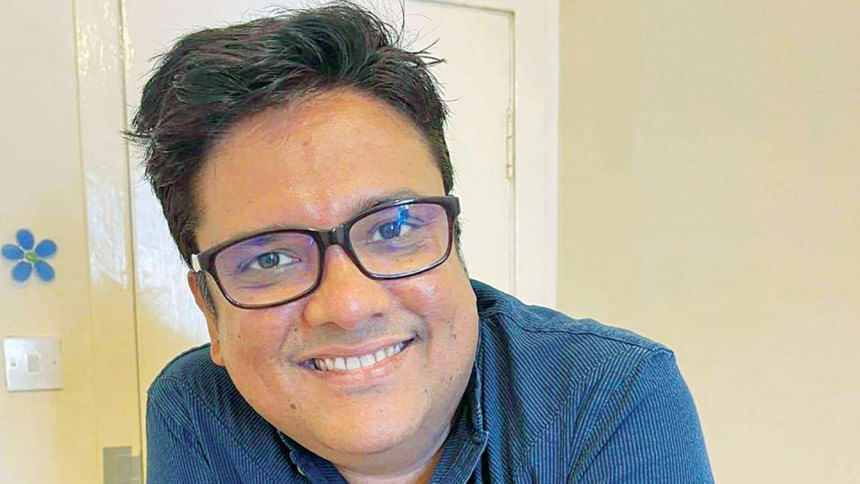From bamboo experiments to global awards

Imagine a home so strong it can withstand the fiercest of hazards be it floods, cyclones, salinity, wildfires, even earthquakes. A home that not only shelters its residents but also provides safe drinking water from every tap, produces organic food, runs on renewable energy, and treats its own waste without polluting the environment.
Most people, on hearing this, react with disbelief. This is too good to be true. That is the response Dr Nandan Mukherjee, a Bangladeshi researcher at the University of Dundee, most often encounters when he describes his design for a climate-resilient home.
Born from collective imagination
What began as a research experiment has become a reality born of co-creation. Over more than a decade, Nandan's team at the University of Dundee and Centre for Climate Change and Environmental Research (C3ER) at BRAC University asked 18,000 families across Bangladesh to describe their "dream home." More than 500 design workshops later, their concept became something far beyond a laboratory prototype. It is not an individual researcher's invention. It is the collective vision of Bangladeshis, among the world's most climate-exposed communities, devising their own pathway to resilience.
Redefining resilience
Resilience, Nandan insists, is too often misunderstood. It is not just about surviving the next storm but about sustaining life itself. A truly resilient home must guarantee uninterrupted access to food, water, energy and livelihoods before, during and after disaster. When floods strike or cyclones hit, the crisis is not only collapsing roofs and rising water. It is also the lack of safe drinking water, blackouts, lost wages, depleted savings and disrupted livelihoods. Unless those lifelines are secured, families remain trapped in cycles of vulnerability and displacement.

A personal turning point
Nandan's journey began on the banks of the Teesta river, where he met a woman who had lost her child to floodwaters. That moment haunted him. He even questioned whether his PhD research had any purpose, wondering if academia could ever deliver real solutions. In time, he realised that infrastructure alone would not solve these problems. Only a holistic approach combining technology, community knowledge and social justice could.
Early experiments and global recognition with an initial $250,000 grant from the Global Resilience Partnership, his team built three bamboo-based flood-resilient homes in Shariatpur. The project won the UN Risk Award in 2019, received commendation from Times Higher Education as one of the best research projects in the arts and social sciences, and placed Nandan among the world's top 100 scientists driving change.
Lessons from inequality
But recognition offered no protection from politics. The demonstration homes were dismantled after powerful local elites forcibly evicted poor families and took over the structures, which had become magnets for thousands of visitors. For Nandan, it was a devastating lesson: technical brilliance and participatory design by book cannot by themselves overcome entrenched inequality. Poverty persists not for lack of solutions but because it underpins existing power structures.
Undeterred, his team returned to the communities, listening and redesigning once again. With prize money from the United Nations, they engaged with more than 18,000 families and refined their model. In 2022, the world's strongest climate-resilient home was rebuilt in Uttarkhan, Dhaka. It was designed not just as a dwelling but as a permanent research and demonstration site.
The big project: An amphibious home
This climate-resilient house is built on a low-carbon amphibious platform. Imagine a boat or pontoon, operating on Archimedes' principle. The 250-ton structure floats on 300 tons of buoyancy beneath its floor. Unlike a nomadic boathouse, however, it does not drift away: secured by four anchored guideposts, it rises with the water and settles back when floods recede. Nandan calls it not a "floating house" but an "amphibious house."
As the saying goes: "A house is built from bricks and beams; a home is built from love and dreams." For Nandan and his team, designing a resilient home meant rethinking even those bricks and beams.
The construction industry is responsible for nearly 40% of global greenhouse gas emissions. Any housing solution built from carbon-intensive materials would be cosmetic at best. So the team collaborated with scientists worldwide to create a revolutionary brick: made from natural materials, pressed rather than fired, three times stronger than stone and 50% stronger than concrete. Certified by BUET and LGED in Bangladesh, it is now awaiting international accreditation.
Affordable and scalable innovation
But strength alone does not build resilience, affordability does. After testing more than 7,200 "recipes," the team developed a brick that is 90% lower in carbon emissions than traditional fired bricks, 50% cheaper, and designed in interlocking "Lego" form. Construction time is cut fifteen-fold: a house can be built by non-experts in just three weeks. The result: homes that cost less than a basic tin shed. Models start at BDT 5 lakh (£3,700) for a modest two-room house and rise to BDT 25 lakh (£18,500) for a six-room duplex.
Nandan's pitch is striking: "The world's strongest net-zero home, one that produces its own water, food and electricity, and sustains livelihoods without polluting the environment." A prototype already proves the point. Beyond bricks, the team has developed 15 other low-carbon materials from concrete foundations to floor tiles and roofing. All of this is cheaper, greener and more durable than their conventional counterparts.
A home that sustains life
If this sounds like science fiction, the reality is even more extraordinary. The home's vertical aquaponics system can produce 50kg of koi fish organically. Rainwater harvesting is paired with natural filtration that neutralises acidity and minerals to deliver safe drinking water. Indoors, smart egg incubators, microgreens and maroon cultivation create year-round agricultural income. Nandan estimates a household could earn up to BDT 100,000 (£750) a month. This is enough to repay a microfinance loan on the house while still building savings.
Scaling to a global solution
The ambition is planetary. Scaled up, the homes could help reduce 100 gigatons of carbon, around one-third of cumulative global emissions since the Industrial Revolution. All this while directly advancing 13 of the UN's 17 Sustainable Development Goals. Born from the struggles and insights of Bangladeshi families, the design points to solutions for a world of eight billion people living under growing climate stress.
The house stands as proof that resilience is not a fantasy. It is a possibility if we are willing to listen, share power and design for the realities of those on the frontlines of the climate crisis.

 For all latest news, follow The Daily Star's Google News channel.
For all latest news, follow The Daily Star's Google News channel. 



Comments